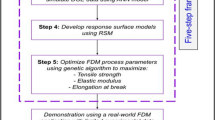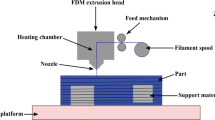Abstract
This paper presents the research done to determine the functional relationship between process parameters and tensile strength for the fused deposition modelling (FDM) process using the group method for data modelling for prediction purposes. An initial test was carried out to determine whether part orientation and raster angle variations affect the tensile strength. It was found that both process parameters affect tensile strength response. Further experimentations were carried out in which the process parameters considered were part orientation, raster angle, raster width and air gap. The process parameters and the experimental results were submitted to the group method of data handling (GMDH), resulting in predicted output, in which the predicted output values were found to correlate very closely with the measured values. Using differential evolution (DE), optimal process parameters have been found to achieve good strength simultaneously for the response. The mathematical model of the response of the tensile strength with respect to the process parameters comprising part orientation, raster angle, raster width and air gap has been developed based on GMDH, and it has been found that the functionality of the additive manufacturing part produced is improved by optimizing the process parameters. The results obtained are very promising, and hence, the approach presented in this paper has practical application for the design and manufacture of parts using additive manufacturing technologies.
Similar content being viewed by others
References
Wiedemann B, Jantzen HA (1999) Strategies and applications for rapid product and process development in Daimler-Benz AG. Comput Ind 39(1):11–25
Upcraft S, Fletcher R (2003) The rapid prototyping technologies. Rapid Prototyp J 23(4):318–330
Mansour S, Hauge SR (2003) Impact of rapid manufacturing on design for manufacturing for injection moulding. Proc Inst Mech Eng B J Eng Manuf 217(4):453–461
Hopkinson N, Hagur RJM, Dickens PH (2006) Rapid manufacturing: an industrial revolution for the digital age. John Wiley and Sons Ltd., England
Bernarand A, Fischer A (2002) New trends in rapid product development. CIRP Annals Manuf Technol 51(2):635–652
Levy GN, Schindel R, Kruth JP, Leuven KU (2003) Rapid manufacturing and rapid tooling with layer manufacturing (LM) technologies—state of the art and future perspectives. CIRP Annals Manuf Technol 52(2):589–609
Pilipović A, Raos P, Šercer M (2009) Experimental analysis of properties of materials for rapid prototyping. Int J Adv Manuf Technol 40(11–12):105–115
Pandey PM, Jain PK, Rao PVM (2009) Effect of delay time on part strength in selective laser sintering. Int J Adv Manuf Technol 43(1–2):117–126
Chockalingama K, Jawahara N, Chandrasekhar U (2006) Influence of layer thickness on mechanical properties in stereolithography. Rapid Prototyp J 12(6):106–113
Ahn SH, Montero M, Odell MD, Roundy S, Wright PK (2002) Anisotropic material properties of fused deposition modelling ABS. Rapid Prototyp J 8(4):248–257
Khan ZA, Lee BH, Abdullah J (2005) Optimization of rapid prototyping parameters for production of flexible ABS object. J Mater Process Technol 169:54–61
Lee CS, Kim SG, Kim HJ, Ahn SH (2007) Measurement of anisotropic compressive strength of rapid prototyping parts. J Mater Process Technol 187–188:637
Wang TM, Xi JT, Jin Y (2007) A model research for prototype warp deformation in the FDM process. Int J Adv Manuf Technol 33(11–12):1087–1096
Bellehumeur CT, Gu P, Sun Q, Rizvi GM (2008) Effect of processing conditions on the bonding quality of FDM polymer filaments. Rapid Prototyp J 14(2):72–80
Chou K, Zhang Y (2008) A parametric study of part distortion in fused deposition modeling using three dimensional element analysis. Proc Inst Mech Eng B J Eng Manuf 222:959–967
Panda SK, Padheee S, Sood AK, Mahapatra SS (2009) Optimization of fused deposition modelling (FDM) process parameters using bacterial foraging technique. Intell Inf Manag 1:89–97
Thrimurthulu K, Pandey PM, Reddy NV (2004) Optimum part deposition orientation in fused deposition modeling. Int J Mach Tools Manuf 4(6):585–594
Montgomery DC (2003) Design and analysis of experiments, 5th edn. John Wiley and Sons Pvt. Ltd., Singapore
Bagsik A (2011) Mechanical properties of fused deposition modeling parts manufactured with Ultem*9085, ANTEC 2011, Boston
Ivakhnenko AG (1971) Polynomial theory of complex systems. IEEE T Syst Man Cyber SMC-1:364–378
Nikolaev NY, Iba H (2003) Polynomial harmonic GMDH learning networks for time series modelling. Neural Netw 16:1527–1540
Anastasakis L, Mort N (2001) The development of self-organization techniques in modelling: a review of the group method of data handling (GMDH). Research Report No. 813, October 2001, Department of Automatic Control & Systems Engineering, The University of Sheffield, Mappin St, Sheffield, S1 3JD, United Kingdom
Onwubolu GC (Ed) (2009) Hybrid self-organizing modeling systems. Springer-Verlag
Madala HR, Ivakhnenko AG (1994) Inductive learning algorithms for complex systems modelling. CRC Press, Boca Raton
Storn R, Price KV (1997) Differential evolution—a simple and efficient heuristic for global optimization over continuous spaces. J Glob Optim 11:341–359
Davendra D, Onwubolu GC (Eds.) (2009) Differential evolution: a handbook for global permutation-based combinatorial optimization (studies in computational intelligence). Springer-Verlag
Storn R, Price K (1995) Differential evolution: a simple and efficient adaptive scheme for global optimization over continuous space: technical report TR-95-012. International Computer Science Institute, Berkeley, CA
Price KV (1999) New ideas in optimization. McGraw-Hill Ltd, UK, pp 79–108, An introduction to differential evolution
Price KV, Storn RM, Lampinen JA (2005) Differential evolution: a practical approach to global optimization. Springer
Author information
Authors and Affiliations
Corresponding author
Rights and permissions
About this article
Cite this article
Rayegani, F., Onwubolu, G.C. Fused deposition modelling (FDM) process parameter prediction and optimization using group method for data handling (GMDH) and differential evolution (DE). Int J Adv Manuf Technol 73, 509–519 (2014). https://doi.org/10.1007/s00170-014-5835-2
Received:
Accepted:
Published:
Issue Date:
DOI: https://doi.org/10.1007/s00170-014-5835-2




